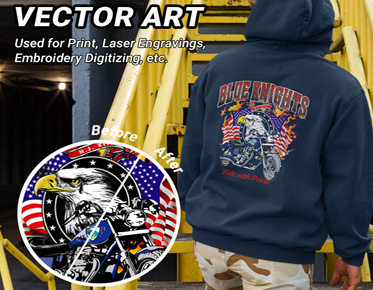Converting Between Embroidery Files: Key Insights You Need
Embroidery file formats are crucial for ensuring that your designs translate correctly from digital files to stitched artwork. Converting between these formats can be a bit of a labyrinth, but with the right knowledge and tools, you can navigate the process with ease. Here’s a comprehensive guide to help you through the conversion process, ensuring that your embroidery designs come out just as you envisioned.
Introduction to Embroidery File Formats
What Are Embroidery File Formats?
Embroidery file formats are specialized digital files used to guide embroidery machines in creating stitched designs. Unlike standard image files, these formats contain detailed instructions for thread colors, stitch types, and patterns. Each format is tailored to specific machines or software, enabling precise control over how your design is embroidered.
The Importance of File Formats in Embroidery
File formats are critical in embroidery because they ensure that the design is accurately translated from a digital blueprint into a tangible fabric piece. The right format can affect the quality, appearance, and functionality of the final embroidery. Using the correct file format ensures compatibility with your embroidery machine, minimizes errors, and maintains the integrity of your design.
Preparing for File Conversion
Assessing Your Needs: Why Conversion is Necessary
Before diving into file conversion, it’s essential to assess why you need to convert your file. Common reasons include needing a design compatible with a different embroidery machine, changing software, or adjusting for specific fabric types. Understanding the purpose of the conversion helps determine the best approach and tools for the job.
Understanding the Source and Target Formats
Each embroidery machine and software may use different file formats, such as .DST, .PES, or .EXP. Understanding both the source (current format) and target (desired format) is crucial. Research the requirements and capabilities of each format to ensure a smooth conversion process. This knowledge helps avoid compatibility issues and ensures the final design meets your specifications.
Gathering Essential Tools and Software for Conversion
Successful conversion relies on having the right tools. Most conversions require specialized embroidery software that can handle various formats. Popular options include Wilcom, Hatch, and Brother’s PE-Design. Additionally, ensure you have access to any required drivers or updates for your embroidery machine to avoid compatibility problems.
Step-by-Step Conversion Process
Choosing the Right Conversion Software: Options and Features
Selecting the appropriate software is the first step in the conversion process. Look for software that supports both your source and target formats. Features to consider include ease of use, compatibility with your machine, and the ability to adjust design settings. Some software options offer advanced features like stitch simulation and color management, which can be valuable for complex designs.
Importing Your Design: Uploading Files for Conversion
Once you’ve chosen your software, import the design file into the program. This normally entails opening the file using the software's interface. Ensure that the file is correctly loaded and that the software recognizes it. If there are any errors during import, check for file corruption or compatibility issues.
Selecting the Output Format: What to Consider
When selecting the output format, consider the requirements of your embroidery machine or software. Different machines may require specific formats to function correctly. Additionally, think about the type of fabric and thread you’ll be using, as this can influence the best format for your design. Choose a format that maintains the design’s quality and meets your machine’s specifications.
Adjusting Design Settings: Ensuring Compatibility
After selecting the output format, adjust the design settings to ensure compatibility. This might include resizing, modifying stitch types, or tweaking thread colors. Pay attention to details such as stitch density and alignment, as these can impact the outcome. Proper adjustments help avoid issues like misalignment or distortion in the final embroidered piece.
Converting the File: Click, Convert, and Check
With all settings in place, proceed with the conversion. This typically involves clicking a “convert” button in your software. Once the conversion is complete, review the new file to ensure it meets your expectations. Look for any anomalies or errors that might have occurred during the conversion process.
Post-Conversion Checks
Inspecting Your Design: Quality and Accuracy Review
After conversion, inspect the design carefully. Check for any discrepancies in color, stitch types, or design details. Use your embroidery software’s preview function to simulate how the design will appear once stitched. This step helps catch any issues before you proceed to the actual embroidery.
Testing the Design: Running Sample Stitches
Running a sample stitch is an essential step in the post-conversion process. This involves embroidering a small section of the design on a sample fabric. Testing allows you to verify that the design translates correctly from digital files to physical fabric and helps identify any issues that need addressing.
Making Adjustments: Fixing Errors and Enhancing Quality
Based on your inspection and sample stitching, make any necessary adjustments to improve the design’s quality. This might involve tweaking stitch density, adjusting colors, or correcting alignment issues. Refining your design ensures that the final embroidered piece meets your standards and performs as expected.
Common Issues and How to Fix Them
Color Discrepancies: Matching Thread Colors Across Formats
Color discrepancies are a common issue when converting between formats. Different formats and machines may interpret colors differently. To address this, ensure that thread colors are accurately matched between the source and target formats. Use color charts and reference guides provided by your embroidery software or thread manufacturer.
Stitch Density Problems: Adjusting for Different Formats
Stitch density can vary between formats, affecting the texture and appearance of the final embroidery. Adjust the stitch density settings in your software to ensure that the design translates well across different formats. Test the design on the fabric to confirm that the stitch density is appropriate for the material.
Design Alignment and Scaling: Ensuring Correct Placement
Alignment and scaling issues can occur during conversion, leading to misaligned or distorted designs. Ensure that the design is correctly aligned and scaled according to your specifications. Use your software’s alignment tools and preview functions to check for accuracy before finalizing the design.
Advanced Conversion Tips
Handling Complex Designs: Special Considerations
Complex designs with intricate details may require special attention during conversion. Ensure that your software can handle the complexity of your design and that all elements are accurately converted. Consider breaking down the design into smaller sections if necessary and reassembling it after conversion.
Converting Between Proprietary Formats: Challenges and Solutions
Converting between proprietary formats can present unique challenges, as each format may have specific requirements and limitations. Research the characteristics of each proprietary format and use software that supports these formats to ensure a successful conversion. Seek guidance from software support or forums if you encounter issues.
Managing Multi-Color Designs: Ensuring Color Integrity
Managing multi-color designs requires careful color management to maintain color integrity across formats. Ensure that your software supports the full range of colors used in your design and that colors are accurately represented in the target format. Test the design on the fabric to verify that the colors are reproduced correctly.
Software-Specific Conversion Techniques
Converting Files for Popular Software: Tips and Tricks
Different embroidery software may have unique methods for file conversion. Familiarize yourself with the specific features and settings of your chosen software. Use available resources, such as tutorials and support forums, to learn best practices for converting files within the software.
Dealing with Machine-Specific Formats: Compatibility Issues
Machine-specific formats can present compatibility issues, as different machines may require unique file formats. Ensure that the converted file is compatible with your specific embroidery machine. Consult the machine’s manual or manufacturer’s support for guidance on handling machine-specific formats.
Exporting and Importing Designs Between Different Platforms
When exporting and importing designs between different platforms, ensure that file compatibility is maintained. Use standard formats, such as .DST or .PES, which are widely supported. Verify the integrity of the design after importing it into the new platform to ensure that no details are lost or altered.
Troubleshooting Common Conversion Problems
Resolving Conversion Errors: Step-by-Step Solutions
Conversion errors can occur due to various factors, such as file corruption or software issues. Follow a step-by-step approach to resolve errors, including checking file integrity, updating software, and verifying compatibility. Consult support resources or forums if the issue persists.
Fixing Common File Issues: Alignment, Color, and Size
Common file issues include misalignment, color discrepancies, and incorrect sizing. Address these problems by adjusting design settings in your software, verifying color accuracy, and ensuring proper alignment. Perform sample stitching to confirm that the issues have been resolved.
When Conversion Doesn’t Work: Alternative Solutions
If conversion fails or results in unsatisfactory outcomes, consider alternative solutions. This may include using different software, manually adjusting the design, or seeking assistance from embroidery experts. Exploring alternative methods can help achieve the desired results.
Best Practices for Effective File Conversion
Ensuring Design Quality: What to Look For
To ensure design quality, focus on maintaining accuracy in color, stitch types, and alignment. Use high-quality files and check for any errors or discrepancies before finalizing the design. Regularly test your designs to ensure they meet your quality standards.
Maintaining Design Integrity Across Formats
Maintaining design integrity involves ensuring that the design remains true to its original form after conversion. Verify that all elements of the design, including colors and stitches, are preserved accurately. Use consistent settings and software to minimize changes during conversion.
Regular Testing: Why It’s Crucial for Success
Regular testing is crucial for ensuring that your designs translate correctly from digital files to embroidered products. Run sample stitches and review design quality frequently to catch any issues early. Testing helps ensure that the final product meets your expectations and performs as intended.
Converting between embroidery file formats requires careful attention to detail and a good understanding of both the source and target formats. By following the steps outlined and employing best practices, you can achieve high-quality results and ensure that your designs are accurately represented in the final embroidered piece. Embrace the process, keep practicing, and continue learning to refine your skills in file conversion.



